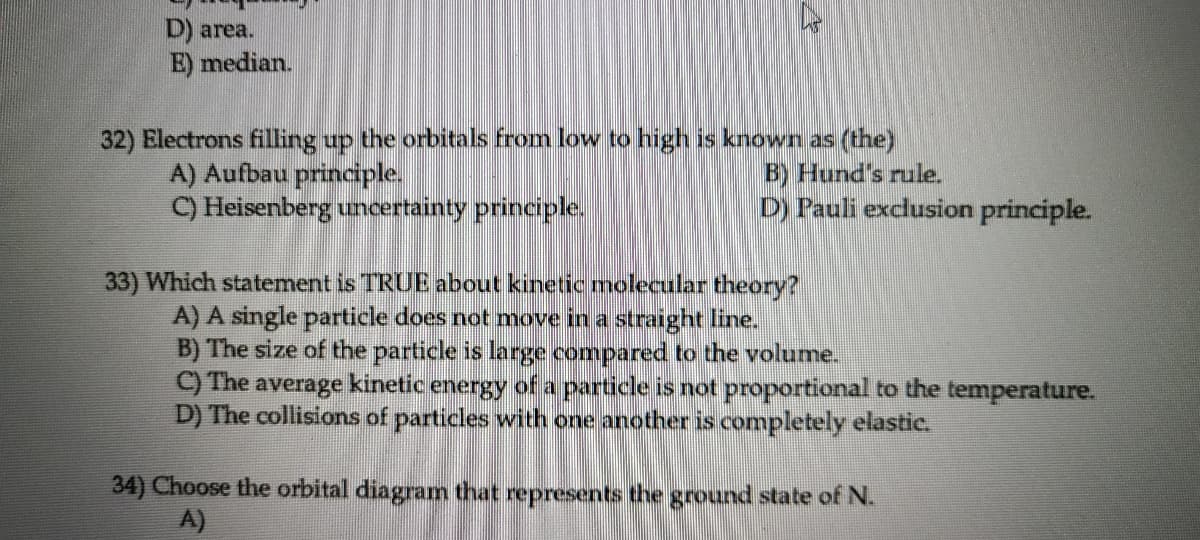32) Electrons filling up the orbitals from low to high is known as (the) A) Aufbau principle. C) Heisenberg uncertainty principle. B) Hund's rule. D) Pauli exclusion principle. 33) Which statement is TRUE about kinetic molecular theory? A) A single particle does not move in a straight line. B) The size of the particle is large compared to the volume. C) The average kinetic energy of a particle is not proportional to the temperature. D) The collisions of particles with one another is completely elastic.
32) Electrons filling up the orbitals from low to high is known as (the) A) Aufbau principle. C) Heisenberg uncertainty principle. B) Hund's rule. D) Pauli exclusion principle. 33) Which statement is TRUE about kinetic molecular theory? A) A single particle does not move in a straight line. B) The size of the particle is large compared to the volume. C) The average kinetic energy of a particle is not proportional to the temperature. D) The collisions of particles with one another is completely elastic.
World of Chemistry, 3rd edition
3rd Edition
ISBN:9781133109655
Author:Steven S. Zumdahl, Susan L. Zumdahl, Donald J. DeCoste
Publisher:Steven S. Zumdahl, Susan L. Zumdahl, Donald J. DeCoste
Chapter11: Modern Atomic Theory
Section: Chapter Questions
Problem 29A
Related questions
Question

Transcribed Image Text:D) area.
E) median.
32) Electrons filling up the orbitals from low to high is known as (the)
A) Aufbau principle.
C) Heisenberg uncertainty principle.
B) Hund's rule.
D Pauli exclusion principle.
33) Which statement is TRUE about kinetic molecular theory?
A) A single particle does not move in a straight line.
B) The size of the particle is large compared to the volume.
C) The
D) The collisions of particles with one another is completely elastic.
average
kinetic
energy
of a particle is not proportional to the temperature.
34) Choose the orbital diagram that represents the ground state of N.
A)
Expert Solution
This question has been solved!
Explore an expertly crafted, step-by-step solution for a thorough understanding of key concepts.
This is a popular solution!
Trending now
This is a popular solution!
Step by step
Solved in 2 steps

Knowledge Booster
Learn more about
Need a deep-dive on the concept behind this application? Look no further. Learn more about this topic, chemistry and related others by exploring similar questions and additional content below.Recommended textbooks for you

World of Chemistry, 3rd edition
Chemistry
ISBN:
9781133109655
Author:
Steven S. Zumdahl, Susan L. Zumdahl, Donald J. DeCoste
Publisher:
Brooks / Cole / Cengage Learning

Principles of Modern Chemistry
Chemistry
ISBN:
9781305079113
Author:
David W. Oxtoby, H. Pat Gillis, Laurie J. Butler
Publisher:
Cengage Learning

Introductory Chemistry: An Active Learning Approa…
Chemistry
ISBN:
9781305079250
Author:
Mark S. Cracolice, Ed Peters
Publisher:
Cengage Learning

World of Chemistry, 3rd edition
Chemistry
ISBN:
9781133109655
Author:
Steven S. Zumdahl, Susan L. Zumdahl, Donald J. DeCoste
Publisher:
Brooks / Cole / Cengage Learning

Principles of Modern Chemistry
Chemistry
ISBN:
9781305079113
Author:
David W. Oxtoby, H. Pat Gillis, Laurie J. Butler
Publisher:
Cengage Learning

Introductory Chemistry: An Active Learning Approa…
Chemistry
ISBN:
9781305079250
Author:
Mark S. Cracolice, Ed Peters
Publisher:
Cengage Learning

Physical Chemistry
Chemistry
ISBN:
9781133958437
Author:
Ball, David W. (david Warren), BAER, Tomas
Publisher:
Wadsworth Cengage Learning,

Chemistry: Matter and Change
Chemistry
ISBN:
9780078746376
Author:
Dinah Zike, Laurel Dingrando, Nicholas Hainen, Cheryl Wistrom
Publisher:
Glencoe/McGraw-Hill School Pub Co

Introductory Chemistry: A Foundation
Chemistry
ISBN:
9781337399425
Author:
Steven S. Zumdahl, Donald J. DeCoste
Publisher:
Cengage Learning